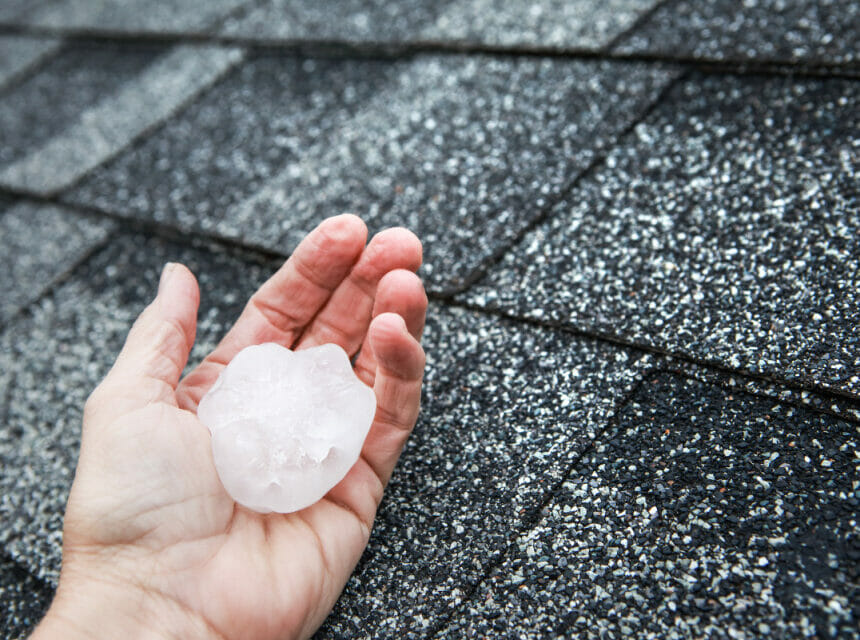Hail can be a serious threat to your home, especially your roof. It is a type of precipitation that occurs during severe thunderstorms and is formed when strong updrafts in a thunderstorm carry raindrops high into the atmosphere, where they freeze into ice. As the hailstones grow larger, they eventually become too heavy for the updrafts to support, and they fall to the ground. Hailstones can vary in size from small pea-sized pellets to large grapefruit-sized chunks.
When hail falls on a roof, it can cause significant damage. The impact of the hailstones can crack or break shingles, dislodge granules, and cause dents or punctures in metal roofs. This damage can weaken the roof’s structure and reduce its ability to protect your home from water damage. Even if the damage is not immediately apparent, it can lead to leaks and other problems over time. If you suspect that your roof has been damaged by hail, it’s important to have it inspected by a professional roofing contractor to determine the extent of the damage and make any necessary repairs.
Different kinds of hail damage you should look out for:
Dented or punctured shingles: Hailstones can leave dents or punctures in your roof’s shingles, which can compromise their ability to protect your home from water damage.
Dislodged granules: Hailstones can knock off the protective granules on shingles, exposing the underlying asphalt to UV rays and other weathering factors. This can cause the shingles to deteriorate more quickly than they otherwise would.
Cracked or broken tiles: Hailstones can crack or break roof tiles, which can weaken the roof’s structure and increase the risk of water damage.
Damage to gutters and downspouts: Hailstones can dent or damage gutters and downspouts, preventing them from functioning properly and causing water to accumulate on your roof.
Leaks: Hail damage can lead to leaks in your roof, which can cause water damage to your home’s interior and lead to mold growth.
If you suspect that your roof has been damaged by hail, it’s important to look for the following signs:
Missing or broken shingles: High winds can rip off shingles or cause them to break, leaving your roof exposed to the elements.
Dented or punctured shingles: Hailstones can leave dents or punctures in your roof’s shingles, which can compromise their ability to protect your home from water damage.
Dislodged granules: Hailstones can knock off the protective granules on shingles, exposing the underlying asphalt to UV rays and other weathering factors. This can cause the shingles to deteriorate more quickly than they otherwise would.
Water stains on ceilings or walls: Leaks in your roof can cause water to seep into your home, resulting in unsightly stains on your ceilings or walls.
Damaged flashing: Strong winds can cause flashing to become loose or detached, leaving vulnerable areas of your roof exposed.
Loose or clogged gutters: Heavy rain and wind can cause gutters to become loose or clogged with debris, preventing them from effectively directing water away from your home.
If you notice any of these signs after a storm, it’s important to have your roof inspected by a professional roofing contractor to determine the extent of the damage and make any necessary repairs. Ignoring these issues can lead to more costly repairs down the line, as well as potential health hazards such as mold growth.
To prevent hail damage to your roof in the future, consider the following tips:
Install impact-resistant roofing materials: Consider installing materials that are designed to withstand hail, such as metal roofing or shingles made from impact-resistant materials.
Keep your trees trimmed: Overhanging tree branches can cause damage to your roof during a storm. Keep your trees trimmed to prevent them from coming into contact with your roof.
Check your insurance policy: Make sure you have adequate insurance coverage for hail damage. Consider adding extra coverage if you live in an area prone to hailstorms.
Inspect your roof regularly: Regular inspections can help you identify potential problems before they turn into major issues. Look for signs of wear and tear and address any issues promptly.
When it comes to repairing hail damage to your roof, you have two options: do it yourself or hire a professional. While some minor repairs can be done by homeowners, it’s generally best to hire a professional roofing contractor to handle the job. They have the expertise and equipment necessary to safely and effectively repair any damage and can help prevent further damage to your roof. Additionally, if your roof is still under warranty, attempting to make repairs yourself could void the warranty. Hiring a professional can give you peace of mind knowing that the job is done right, and your roof is protected.
Call Axium Inspections Premier Roofing Partner J&K Roofing (720) 336-2206
Hail can be a serious threat to your home, especially your roof. It is a type of precipitation that occurs during severe thunderstorms and is formed when strong updrafts in a thunderstorm carry raindrops high into the atmosphere, where they freeze into ice. As the hailstones grow larger, they eventually become too heavy for the updrafts to support, and they fall to the ground. Hailstones can vary in size from small pea-sized pellets to large grapefruit-sized chunks.
When hail falls on a roof, it can cause significant damage. The impact of the hailstones can crack or break shingles, dislodge granules, and cause dents or punctures in metal roofs. This damage can weaken the roof’s structure and reduce its ability to protect your home from water damage. Even if the damage is not immediately apparent, it can lead to leaks and other problems over time. If you suspect that your roof has been damaged by hail, it’s important to have it inspected by a professional roofing contractor to determine the extent of the damage and make any necessary repairs.
Different kinds of hail damage you should look out for:
Dented or punctured shingles: Hailstones can leave dents or punctures in your roof’s shingles, which can compromise their ability to protect your home from water damage.
Dislodged granules: Hailstones can knock off the protective granules on shingles, exposing the underlying asphalt to UV rays and other weathering factors. This can cause the shingles to deteriorate more quickly than they otherwise would.
Cracked or broken tiles: Hailstones can crack or break roof tiles, which can weaken the roof’s structure and increase the risk of water damage.
Damage to gutters and downspouts: Hailstones can dent or damage gutters and downspouts, preventing them from functioning properly and causing water to accumulate on your roof.
Leaks: Hail damage can lead to leaks in your roof, which can cause water damage to your home’s interior and lead to mold growth.
If you suspect that your roof has been damaged by hail, it’s important to look for the following signs:
Missing or broken shingles: High winds can rip off shingles or cause them to break, leaving your roof exposed to the elements.
Dented or punctured shingles: Hailstones can leave dents or punctures in your roof’s shingles, which can compromise their ability to protect your home from water damage.
Dislodged granules: Hailstones can knock off the protective granules on shingles, exposing the underlying asphalt to UV rays and other weathering factors. This can cause the shingles to deteriorate more quickly than they otherwise would.
Water stains on ceilings or walls: Leaks in your roof can cause water to seep into your home, resulting in unsightly stains on your ceilings or walls.
Damaged flashing: Strong winds can cause flashing to become loose or detached, leaving vulnerable areas of your roof exposed.
Loose or clogged gutters: Heavy rain and wind can cause gutters to become loose or clogged with debris, preventing them from effectively directing water away from your home.
If you notice any of these signs after a storm, it’s important to have your roof inspected by a professional roofing contractor to determine the extent of the damage and make any necessary repairs. Ignoring these issues can lead to more costly repairs down the line, as well as potential health hazards such as mold growth.
To prevent hail damage to your roof in the future, consider the following tips:
Install impact-resistant roofing materials: Consider installing materials that are designed to withstand hail, such as metal roofing or shingles made from impact-resistant materials.
Keep your trees trimmed: Overhanging tree branches can cause damage to your roof during a storm. Keep your trees trimmed to prevent them from coming into contact with your roof.
Check your insurance policy: Make sure you have adequate insurance coverage for hail damage. Consider adding extra coverage if you live in an area prone to hailstorms.
Inspect your roof regularly: Regular inspections can help you identify potential problems before they turn into major issues. Look for signs of wear and tear and address any issues promptly.
When it comes to repairing hail damage to your roof, you have two options: do it yourself or hire a professional. While some minor repairs can be done by homeowners, it’s generally best to hire a professional roofing contractor to handle the job. They have the expertise and equipment necessary to safely and effectively repair any damage and can help prevent further damage to your roof. Additionally, if your roof is still under warranty, attempting to make repairs yourself could void the warranty. Hiring a professional can give you peace of mind knowing that the job is done right, and your roof is protected.
Call Axium Inspections Premier Roofing Partner J&K Roofing (720) 336-2206





















